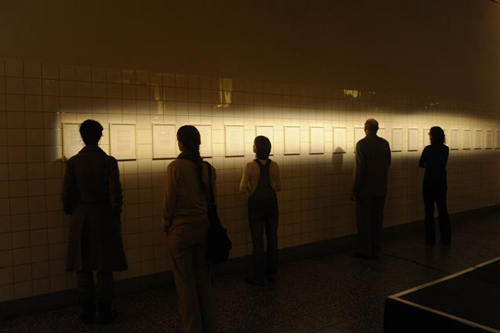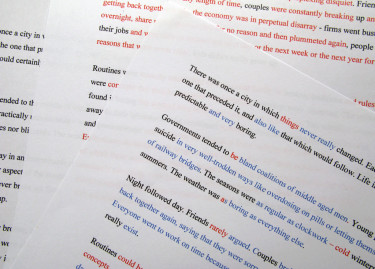As mentioned below City Changes is now showing at PACT Zollverein in Essen. A few installation pictures above. For the opening I wrote a short text for curator Stefan Hilterhaus, about the work and what I hope it is dealing with.
*
Dear Stefan,
Years ago Forced Entertainment rented a couple of garages on the edge of Sheffield. It was in these insecure, damp and dark places that we stored for a long time the boxes of old props and costumes, as well as the sets for old shows, and collected raw or nearly raw materials of one kind or another (timber, furniture, steel bars, scaffolding, random interesting items) which we thought might be of use to us in some as yet unimagined project, at some time or another in the as yet unimagined future. One garage contained the more current materials, the other contained the things we felt less likely to use. But to each site we paid occasional visits, retrieving one thing or another, searching for items we’d lost, or looking for things which we thought we needed again or for which we’d suddenly imaged a use. At a certain point the lock on one of these spaces (the less current one) became so rusted that it was almost impossible to enter, whilst at another point the more current space developed leaks in its roof, a small arson attack damaging its doors and so on. The garages were unstable, entropic. Mostly Richard would drive up the mud track to them alone, bringing things back in the van, along with his reports on the status and usually catastrophic developments of the buildings themselves. Some curtains he might bring back, a crate of costumes, a wind machine, an overhead projector – stuff that we could use or salvage. The garages, I used to joke, were not so much real places though as they were a state of mind – a mental space pitched perfectly between an exhausted past and an intense future set of possibilities – a mental space of both memory and potential, the discarded and the imagined.
*
I’ve always loved cities – as places of social, cultural and political diversity, contestation, change and stasis. For a long time I’ve loved descriptions of them too – from Italo Calvino’s near-impossible conundrum urban spaces, to Dickens’ filthy, stratified and fog-bound London to William Gibson’s sprawling near futures, with the different cities of William Burroughs, Mike Davis, M. John Harrison, Luc Sante, Kathy Acker, Michael Moorcock and a whole host of others in between. A city described is always more than a landscape of course, always more than a set of architectures – like our garages in fact, a city mapped in text is always at some level a state of mind, a set of possibilities and prohibitions, an atmosphere, a philosophy posed as linguistic cartography.In my own writing I’ve been drawn (like several of the writers above) to conceptions of the city as contradictory and incoherent – a three dimensional collage that can (and must) be seen (and used) from a number of different angles in order to be seen (or used) at all.
*
Embarking on the work City Changes I was interested in two main things. The first were the rhetorics that are often wheeled out around cities and change – the various accents (positive and negative) that are placed on stasis, stability and stagnation on the one hand and fluidity, flux, energy, vitality and change itself on the other. I was fascinated by the language that so often surrounds urban space – the language that talks cities up (and talks them down) in everything from travel guides to fiction, to the kind of reports that are produced by NGOS to back-up quangoistic EU redevelopment initiatives. These kinds of stories about cities – fantastical or factual, coolly written or intensely poetic – are always part of a conversation about what we want our lives to be like, about imagining futures and as such of course I think they are always very revealing.The second thing that interested me was the idea of creating a text work that somehow revealed it’s own process. I guess that’s something that comes to me from my work in performance, where my inclination has often been to expose the mechanism of decisions, events and effects – showing choices being made, showing hesitations, re-thinkings and so on as performers go about their work. I wanted to do something similar with City Changes, tracing my rewriting of the text and allowing its proposal to be punctured by the revelation of its own contingency. In this work the City Changes text is something that has layers, history, process – internal tensions and complications that are worn on the sleeve rather than hidden. I think what drew me to that is a desire to demonstrate that words like cities are always choices, always changeable, always loaded political objects.
*
I’m so glad that the works will be shown during Explorationen 08 which I think sounds like a great initiative and context to approach these kinds of topics. I wish you well and hope that the symposium is as creative and inspiring as it can possibly be.
With best wishes to you all,
Tim



 City Changes, 2008
City Changes, 2008